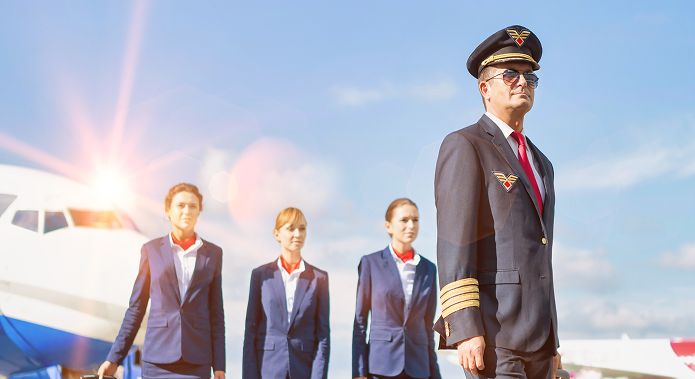A commercial flight simulator is a sophisticated training device designed to replicate the experience of flying an aircraft. These simulators are integral to pilot training programs, offering a safe and controlled environment where pilots can practice and refine their skills without the risks associated with actual flight. They accurately mimic various flight scenarios, aircraft behaviors, and environmental conditions, enabling pilots to experience a wide range of situations, from standard operations to emergency procedures.
At Global Training Aviation (GTA), we utilize state-of-the-art flight simulators to provide comprehensive training solutions. Our simulators are equipped with advanced technology that ensures realistic flight experiences, allowing pilots to gain confidence and proficiency. By incorporating these simulators into our training programs, we ensure that our trainees are well-prepared to handle real-world flying challenges, enhancing overall aviation safety and efficiency.
Key Features of a Commercial Flight Simulator:
Commercial flight simulators are equipped with several key features that enhance pilot training:
At GTA, we integrate these features into our training programs to provide pilots with comprehensive and realistic flight experiences, ensuring they are well-prepared for the challenges of real-world aviation.

Commercial flight simulators come in various types, each designed to offer a unique training experience for pilots.
Full Flight Simulator (FFS)
A Full Flight Simulator (FFS) is an advanced training device that replicates the complete experience of operating an aircraft. It encompasses a full-scale replica of the aircraft’s cockpit, complete with functional controls, instruments, and systems. Mounted on a motion platform, the FFS simulates the physical sensations of flight, including acceleration, turbulence, and maneuvering forces, providing a comprehensive and immersive training environment.
FFS devices are categorized into levels based on their fidelity and capabilities:
At GTA, we utilize state-of-the-art Full Flight Simulators (FFS) to provide high-fidelity training experiences. Our training fleet includes simulators for popular aircraft such as the A320, B737, ATR 600, and ATR 500. These advanced simulators are equipped with the latest technology, offering realistic flight dynamics, immersive visual systems, and motion platforms that replicate the sensations of actual flight. By training on these cutting-edge simulators, our pilots can gain valuable experience in handling various aircraft types, preparing them for real-world scenarios with the highest level of safety and proficiency.
Fixed Base Simulator (FBS)
A Fixed Base Simulator (FBS) is a type of flight training device that replicates the cockpit of an aircraft but lacks the motion platform typically found in a Full Flight Simulator (FFS). While it does not simulate the physical sensations of flight, such as acceleration or turbulence, an FBS still provides a highly realistic environment for pilots to practice procedures, controls, and systems management. It includes a detailed cockpit replica with functional instruments and displays, allowing pilots to simulate various flight scenarios, including normal operations, emergency procedures, and abnormal situations.
Fixed Base Simulators are an excellent tool for procedural training, system operation familiarization, and practicing specific flight maneuvers. They are often used for recurrent training and refresher courses, where pilots can hone their skills in a safe and controlled environment. Although they do not offer the full immersive experience of an FFS, FBS devices are more affordable and require less space, making them a practical option for training institutions with budget or space limitations.
Flight Training Device (FTD)
A Flight Training Device (FTD) is a lower-level flight simulator designed for specific training tasks. It is primarily used for training pilots in procedural tasks, aircraft systems management, and flight operations in a controlled and cost-effective manner. Unlike Full Flight Simulators (FFS) and Fixed Base Simulators (FBS), FTDs typically lack full cockpit replication and motion systems, focusing instead on the operation of the aircraft’s instruments, controls, and systems.
FTDs are ideal for reinforcing knowledge of aircraft systems, navigation, and emergency procedures. They provide a valuable tool for pilots to familiarize themselves with cockpit layouts, instrument readings, and various flight scenarios without the need for full-motion equipment. These devices are often used in recurrent training programs or when there is a need for highly focused, task-specific training.
Virtual Reality (VR) Simulators
Virtual Reality (VR) Simulators are an innovative and immersive tool in modern pilot training. By using VR headsets and motion-tracking devices, pilots can experience flight in a fully immersive, 3D virtual environment. Unlike traditional simulators, which rely on physical motion platforms, VR simulators create a lifelike representation of the cockpit and external environment, enabling pilots to interact with controls and instruments as they would in real life. This technology allows pilots to practice a wide range of scenarios, from routine flights to complex emergency situations, all within a highly realistic virtual space.


Commercial flight simulators offer a wide range of benefits that are essential for effective pilot training.
Commercial flight simulators are primarily used by airline pilots for both initial training and recurrent certification, allowing them to practice a wide range of scenarios safely.
Flight schools and pilot training organizations also use simulators to teach essential flight skills, emergency procedures, and aircraft handling.
Aviation regulators rely on simulators to assess pilot competence and ensure safety standards are met.
Additionally, airlines and aviation companies use flight simulators for crew training, including cabin crew and ground staff, ensuring all personnel are equipped with the necessary knowledge and skills.

The future of pilot training will be heavily influenced by advancements in flight simulators and virtual reality (VR). Simulators will continue to offer immersive, cost-effective training, allowing pilots to practice a wide range of scenarios without the need for real aircraft. With the integration of technologies like AI, machine learning, and enhanced VR, training will become more personalized, efficient, and accessible. These developments will help pilots improve their skills, reduce training costs, and ensure they are better prepared for the complexities of modern aviation, all while maintaining high safety standards.